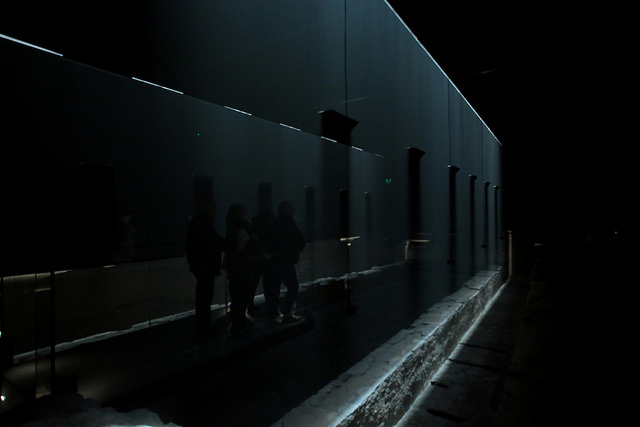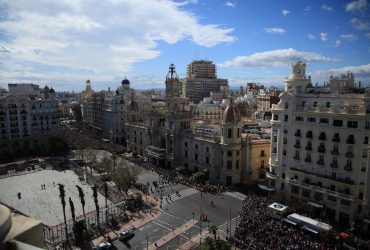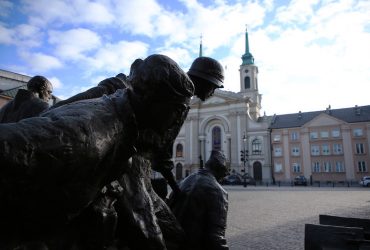Today I want to talk to you about London, to find out more about the English capital and its most interesting stories and places.
 Let’s start with Highgate Cemetery, located in the Highgate district (north of the city). Opened in 1839, as part of a plan for the construction of seven large and modern cemeteries outside the town of London (called “Magnificent Seven”), today it is included in the Register of Parks and Gardens (National Register of Historic Parks and Gardens) of special historic interest in England. It is divided into two parts, eastern and western, and about 170,000 people are buried in about 53,000 graves.
Let’s start with Highgate Cemetery, located in the Highgate district (north of the city). Opened in 1839, as part of a plan for the construction of seven large and modern cemeteries outside the town of London (called “Magnificent Seven”), today it is included in the Register of Parks and Gardens (National Register of Historic Parks and Gardens) of special historic interest in England. It is divided into two parts, eastern and western, and about 170,000 people are buried in about 53,000 graves.
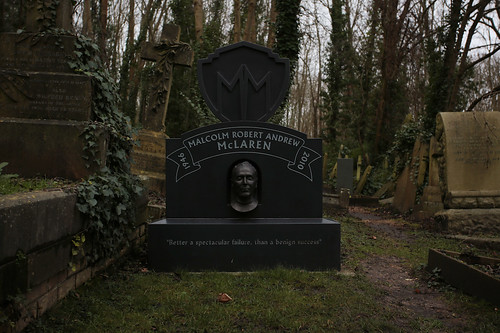 The western part is the oldest one, in Victorian style, and is accessible only by taking part in guided tours; the east part, however, can be visited without taking part in guided tours and the ticket costs 4 pounds. If you are interested in “famous tombs” tours, there are plenty of them at Highgate! To give just a few examples, you can find here the burials of Karl Marx, Douglas Adams (recognisable by the pen holder in front of the tombstone), George Elliot and Malcolm McLaren (impresario, among others, of the Sex Pistol).
The western part is the oldest one, in Victorian style, and is accessible only by taking part in guided tours; the east part, however, can be visited without taking part in guided tours and the ticket costs 4 pounds. If you are interested in “famous tombs” tours, there are plenty of them at Highgate! To give just a few examples, you can find here the burials of Karl Marx, Douglas Adams (recognisable by the pen holder in front of the tombstone), George Elliot and Malcolm McLaren (impresario, among others, of the Sex Pistol).
The nearest metro station is Archway (Northern line, High Barnet branch) and NOT Highgate. From the metro station, you can take several buses or take a 10-minute walk. I refer you to the cemetery official website for all further information.
 In the heart of the city of London, the city’s financial centre lies the London Stone. This stone is set in the outer wall of the building at 111 Cannon Street, protected by a grating and in this period is exposed to the museum in London because the building is being renovated. Why do I speak to you about a stone? This limestone monolith (practically the size of a hand baggage 53 × 43 × 30 cm), named for the first time in the XXII century, has mysterious origins that seem to have been used by the Romans to measure the distances from Londinium. There is a saying that reads: “Until the stone of Brutus is sure, London will prosper”; from this, it was born the belief that the existence of the city is linked to this stone.
In the heart of the city of London, the city’s financial centre lies the London Stone. This stone is set in the outer wall of the building at 111 Cannon Street, protected by a grating and in this period is exposed to the museum in London because the building is being renovated. Why do I speak to you about a stone? This limestone monolith (practically the size of a hand baggage 53 × 43 × 30 cm), named for the first time in the XXII century, has mysterious origins that seem to have been used by the Romans to measure the distances from Londinium. There is a saying that reads: “Until the stone of Brutus is sure, London will prosper”; from this, it was born the belief that the existence of the city is linked to this stone.
The nearest underground station is Cannon Street (Circle and District line).
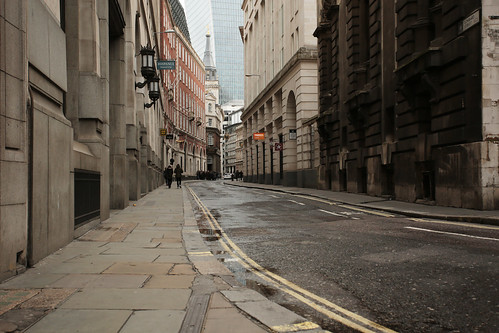 Without moving from the City of London, I will take you to Lombard street. What’s so strange about this narrow street in the London financial district? It probably takes little to understand it from its name: here, in the Middle Ages, mainly merchants and bankers from Lombardy used to work. This is a case of geographical toponymy, which arises from the geographic origin of those who worked there (similar to what can be observed, for example in the centre of Rome with all the streets that take their name from the type of work that was done in past centuries).
Without moving from the City of London, I will take you to Lombard street. What’s so strange about this narrow street in the London financial district? It probably takes little to understand it from its name: here, in the Middle Ages, mainly merchants and bankers from Lombardy used to work. This is a case of geographical toponymy, which arises from the geographic origin of those who worked there (similar to what can be observed, for example in the centre of Rome with all the streets that take their name from the type of work that was done in past centuries).
The nearest underground station is Bank (Northern line, central line and Waterloo & city line), located just at the beginning of the street; the cannon street station is about 5-6 minutes on foot.
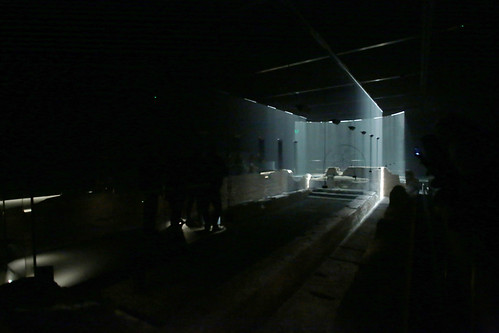 As you will have understood, by now, the city of London offers many stories from the city’s past. Precisely for this reason, now I want to mention also the Temple of Mithras. It dates back to the time of the Roman Londinium and built during the imperial age in the area once crossed by the Walbrook stream, a tributary of the river Thames. Today it is under the street level, “underneath” the Bloomsbury building, and I have to admit that it was not easy to understand what the entrance was: from outside it seemed more like an art gallery than the door of an ancient temple to go and visit an old Roman temple!
As you will have understood, by now, the city of London offers many stories from the city’s past. Precisely for this reason, now I want to mention also the Temple of Mithras. It dates back to the time of the Roman Londinium and built during the imperial age in the area once crossed by the Walbrook stream, a tributary of the river Thames. Today it is under the street level, “underneath” the Bloomsbury building, and I have to admit that it was not easy to understand what the entrance was: from outside it seemed more like an art gallery than the door of an ancient temple to go and visit an old Roman temple!
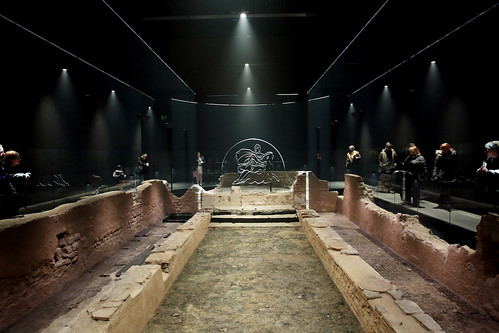 Admission is free, and the visit starts from the street level with a wall along which numerous finds were discovered during excavations for the construction of the building. The best thing is that you can have all the information by browsing and selecting the individual findings from an app installed on the tablet available to visitors (if you do not give it, ask someone from the staff)! Then you will move to a sort of “waiting room” in the basement, where reconstructions and audio presentation and story are found: access to the remains is controlled, and only a few people can enter every twenty minutes.
Admission is free, and the visit starts from the street level with a wall along which numerous finds were discovered during excavations for the construction of the building. The best thing is that you can have all the information by browsing and selecting the individual findings from an app installed on the tablet available to visitors (if you do not give it, ask someone from the staff)! Then you will move to a sort of “waiting room” in the basement, where reconstructions and audio presentation and story are found: access to the remains is controlled, and only a few people can enter every twenty minutes.
 The visit begins in the dark with “play of light” that aims to give an idea of the temple in its entirety, while in the background there is the audio of a rite in honour of Mithras (as I interpreted it): the atmosphere was exceptional, almost “magical”. Once this audio-visual reconstruction is over, visitors have still several minutes to take pictures of the remains (illuminated, of course). The nearest underground station is Cannon Street (Circle and District line), less than a minute away. Not too far is the Bank stop (Northern line, central line and Waterloo & city line).
The visit begins in the dark with “play of light” that aims to give an idea of the temple in its entirety, while in the background there is the audio of a rite in honour of Mithras (as I interpreted it): the atmosphere was exceptional, almost “magical”. Once this audio-visual reconstruction is over, visitors have still several minutes to take pictures of the remains (illuminated, of course). The nearest underground station is Cannon Street (Circle and District line), less than a minute away. Not too far is the Bank stop (Northern line, central line and Waterloo & city line).
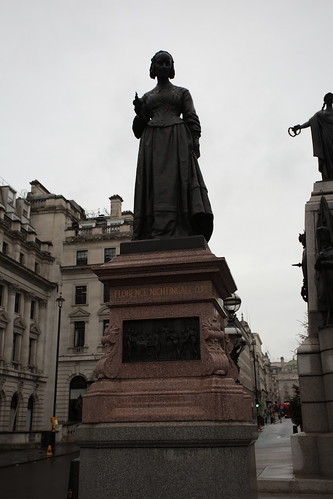 I conclude by pointing out the statue of Florence Nightingale, located in Waterloo place, which is part of the “Crimean War Memorial”. The memorial was made in 1915, 60 years after the war, and includes the statue of Florence Nightingale because he wants to commemorate the nurses as well as the soldiers: also remembers, therefore, the contribution of Florence Nightingale in the life of all (civil and military). The memorial is located in Waterloo-place, a small square along the street called Pall-mall, and is located “in front of the column dedicated to the Duke of York of which I had spoken in a post last November. It is approximately halfway between the Piccadilly Circus underground stations (Bakerloo and Piccadilly line) and Charing Cross (Bakerloo and Northern line)
I conclude by pointing out the statue of Florence Nightingale, located in Waterloo place, which is part of the “Crimean War Memorial”. The memorial was made in 1915, 60 years after the war, and includes the statue of Florence Nightingale because he wants to commemorate the nurses as well as the soldiers: also remembers, therefore, the contribution of Florence Nightingale in the life of all (civil and military). The memorial is located in Waterloo-place, a small square along the street called Pall-mall, and is located “in front of the column dedicated to the Duke of York of which I had spoken in a post last November. It is approximately halfway between the Piccadilly Circus underground stations (Bakerloo and Piccadilly line) and Charing Cross (Bakerloo and Northern line)
London: places and stories to discover
